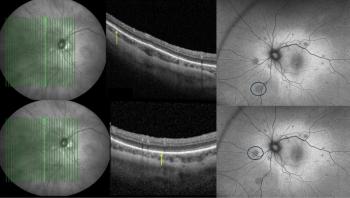
- Ophthalmology Times Europe July/August 2022
- Volume 18
- Issue 06
Bariatric surgery may result in less sight-threatening diabetic retinopathy
One systematic review and meta-analysis finds bariatric surgery associated with fewer cases of diabetic retinopathy overall and of sight-threatening progression.
Reviewed by Dr Caberry Weiyang Yu.
Diabetic retinopathy (DR) is a threat to vision in patients with type 2 diabetes and a cause of lost sleep for ophthalmologists when they cannot save patients’ vision. One bright spot, however, is that bariatric surgery—an effective treatment for obesity in patients with type 2 diabetes—can induce remission of the diabetes and reduce microvascular complications, according to Dr Caberry Weiyang Yu, of the Division of Ophthalmology, Department of Surgery at McMaster University in Toronto, Canada.
It has been suggested that DR can actually worsen after bariatric surgery as a result of the rapid improvement in hyperglycaemia. In the light of this possible drawback, Dr Yu and her colleagues performed a systematic review and meta-analysis to determine the impact of bariatric surgery on DR for an obese diabetic population, compared with controls treated with medical therapy.
The investigators conducted a search of the MEDLINE, Embase, Cochrane Library and Web of Science databases upuntil March 2020, for studies that compared patients with DR who had undergone bariatric surgery with those treated medically.The primary outcomes were the prevalence rates of all cases of DR and sight-threatening DR postoperatively; the secondary outcomes were worsening of DR within 12 months and thereafter.
Sight-threatening DR was defined as proliferative or pre-proliferative DR or diabetic maculopathy or severe non-proliferative DR. A total of 14 studies, which included 110,300 surgical patients and 252,289 control patients, were identified; all studies had a low risk of bias.
Almost three-quarters of the patients with type 2 diabetes were women (mean age, 42.6 years; mean body mass indices [BMIs] preoperatively and postoperatively, 44.8 and 30.5 kg/m2, respectively). The difference in preoperative BMIs compared with postoperative BMIs was a reduction of 31.9%.
Four types of bariatric surgery were performed in the identified studies: Roux-en-Y gastric bypass, laparoscopic sleeve gastrectomy, laparoscopic adjustable gastric bypass and biliopancreatic diversion.
Outcomes of bariatric surgery
At follow-up, Dr Yu reported that the DR prevalence rates were 0.45% in patients who underwent bariatric surgeryand 1.03% in patients who had medical management only. “The risk of having any DR for the surgical patients was 83% lower compared with non-surgical patients at a median follow-up of 8 years,” she stated.
Moreover, undergoing bariatric surgery was seen to reduce the prevalence of sight-threatening DR by 53% at the median follow-up of 4 years compared with patients treated medically. Regarding the risk of early progression of DR, particularly within 12 months and associated with bariatric surgery, Dr Yu reported that the condition progressed to sight-threatening DR more often in patients whose DR was severe at baseline.
In patients with baseline non-proliferative DR, early progression of all DR did not differ between the two study groups, occurring in about one in seven patients. However, in those who had existing proliferative DR at baseline, complications such as intraocular haemorrhage developed in four out of five patients during the first year.
After the 12-month time point, significantly fewer patients (71%) who underwent bariatric surgery had worsening of DR at a median of 5 years. Progression occurred in up to 8% of patients followed for between 2 and 13 years postoperatively.
“In obese patients with type 2 diabetes, bariatric surgery was associated with fewer cases of all and sight-threatening DR,” Dr Yu concluded. “The severity of the baseline DR was an important sign of early worsening of DR postoperatively. Early screening for patients with existing sight-threatening DR who undergo bariatric surgery is needed.”
Caberry Weiyang Yu, MD
E: [email protected]
This article is adapted from Dr Yu’s presentation at the American Academy of Ophthalmology annual meeting on November 13, 2021, in New Orleans, Louisiana, United States. Dr Yu has no financial interest in this subject matter.
Articles in this issue
about 3 years ago
New insights into macular carotenoid accumulation and transportover 3 years ago
Novel devices, drugs trigger rapid glaucoma market expansionover 3 years ago
Averting zonular crises in different types of cataract patientsNewsletter
Get the essential updates shaping the future of pharma manufacturing and compliance—subscribe today to Pharmaceutical Technology and never miss a breakthrough.













































